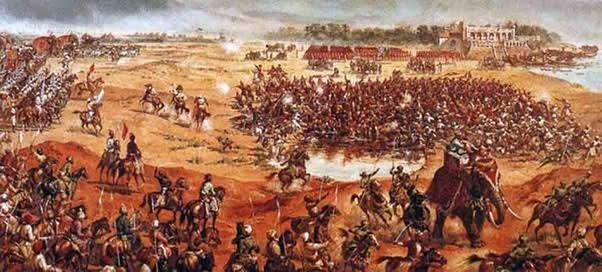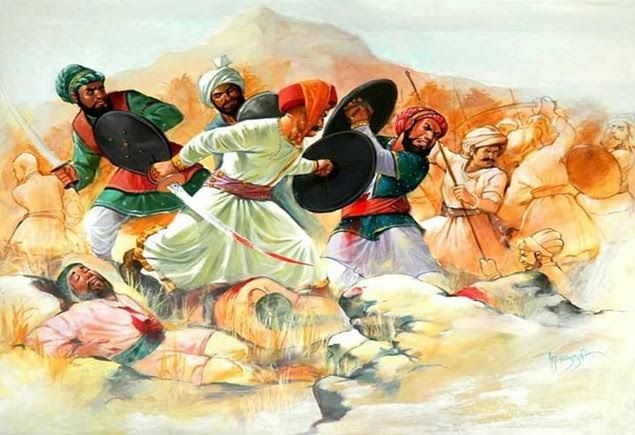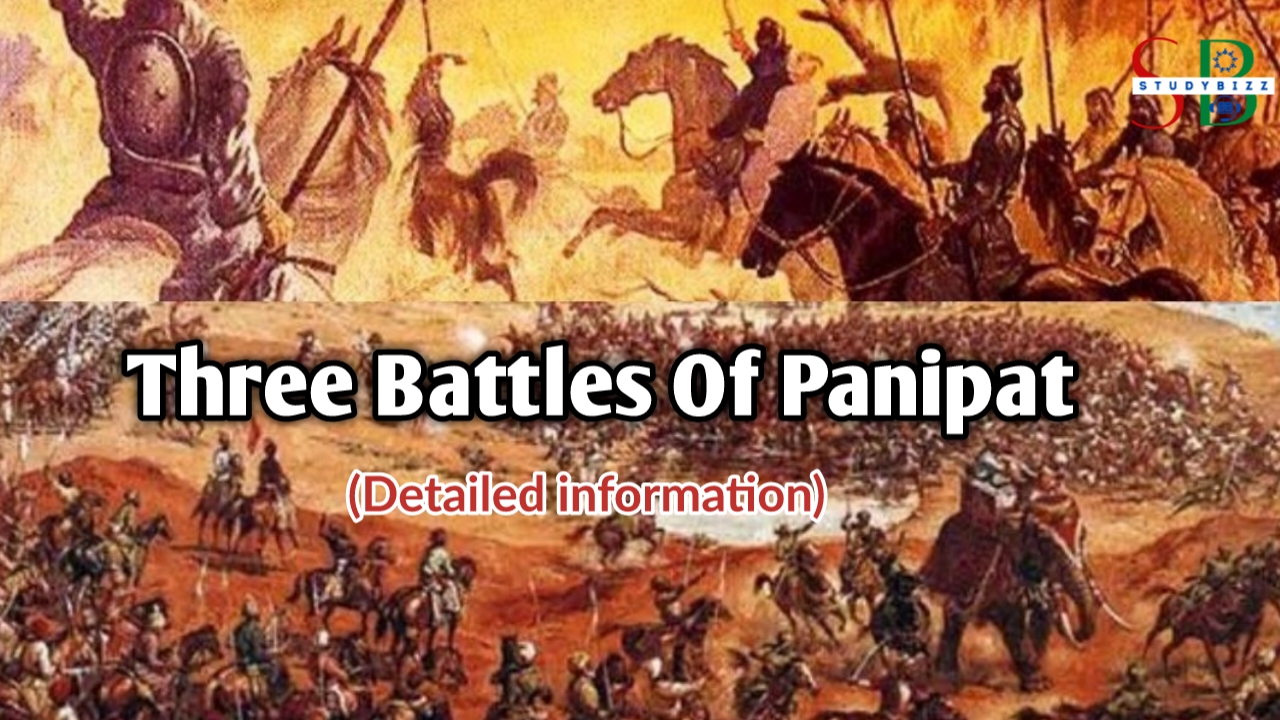The Battle of Panipat refers to three significant battles fought near the town of Panipat in northern India during the medieval period:
Three Battles of Panipat in brief
1. First Battle of Panipat (1526): The very first Panipat Battle took place between the forces of Babur, the founder of the Mughal Empire, and Ibrahim Lodi, the last Sultan of Delhi. Babur’s victory marked the beginning of the historical rule of Mughals in India.
2. Second Battle of Panipat (1556): Second Battle occurred during the mughal period. The battle was fought between the forces of Akbar, the third Mughal emperor, and Hemu, a Hindu general and chief minister in the regime of the Suri dynasty. Akbar’s victory solidified Mughal control over northern India.
3. Third Battle of Panipat (1761): This battle was fought between the Maratha Empire and the Durrani Empire (led by Ahmad Shah Durrani, also known as Ahmad Shah Abdali). The Marathas suffered a devastating defeat, leading to a significant decline in their power and influence in India.
The First Battle of Panipat (1526)
The First Battle of Panipat, fought on April 21, 1526, was a significant confrontation between the forces of Babur, the founder of the Mughal Empire, and Ibrahim Lodi, the last Sultan of Delhi. Here’s a detailed note:

Background:
– Babur, originally from Central Asia, had already established his rule in parts of Afghanistan and Central Asia.
– Ibrahim Lodi was the ruling Sultan of the Delhi Sultanate, but his rule was marked by internal conflicts and discontent among various factions.
Causes:
– Babur had set his sights on expanding his empire into the Indian subcontinent.
– The political instability within the Delhi Sultanate provided an opportunity for Babur to invade.
Preparations:
– Babur’s army consisted of well-trained soldiers, including cavalry, artillery, and firearms, which gave him a technological advantage over the forces of Ibrahim Lodi.
– Ibrahim Lodi’s army, though larger in number, lacked the same level of organization and firepower.
The Battle:
– The battle took place near the town of Panipat, located in present-day Haryana, India.
– Babur’s army utilized artillery and firearms effectively, causing chaos and panic among Ibrahim Lodi’s forces.
– Despite their numerical superiority, the lack of coordination and discipline among Ibrahim Lodi’s troops proved detrimental.
– Babur’s strategic maneuvers and the effectiveness of his firearms eventually led to the defeat of Ibrahim Lodi’s army.
Outcome:
– Ibrahim Lodi was killed in the battle, and his forces suffered heavy casualties.
– Babur emerged victorious, establishing the Mughal Empire in India.
– The First Battle of Panipat marked the beginning of Mughal rule in India, which would last for over three centuries.
Significance:
– Babur’s victory laid the foundation for the Mughal Empire’s expansion in India.
– The battle showcased the effectiveness of firearms and artillery in Indian warfare, leading to the widespread adoption of these technologies in subsequent battles.
– It also marked the end of the Delhi Sultanate and the beginning of Mughal dominance in northern India.
The Second Battle of Panipat (1556)
The Second Battle of Panipat occurred on November 5, 1556, and it was fought between the forces of the Mughal Emperor Akbar and the army of Hemu, a powerful Hindu general who was leading the resurgence of the Afghan-led Sur Empire. Here’s a detailed overview:

Background:
– After the death of Babur, his son Humayun struggled to maintain control over the Mughal Empire. During this time, the Sur Empire, led by Sher Shah Suri, rose to power in northern India.
– After years of exile, Humayun regained control of the Mughal Empire with the help of Persian forces.
– However, after Humayun’s death, his young son Akbar ascended to the throne, and the Sur Empire saw an opportunity to regain power under the leadership of Hemu.
Causes:
– Hemu, a skilled administrator and military leader, rallied support from various factions discontented with Mughal rule.
– Akbar, though young, was supported by capable generals and advisors who were determined to maintain Mughal control over India.
Preparations:
– Hemu’s army consisted of a large number of well-trained soldiers, including cavalry and infantry.
– Akbar’s forces were led by experienced commanders like Bairam Khan and were well-equipped with artillery and firearms, thanks to the influence of Persian military tactics.
The Battle:
– The battle took place near Panipat, in present-day Haryana, India.
– Hemu’s forces initially gained the upper hand, with his elephant corps breaking through Akbar’s lines and causing panic among the Mughal ranks.
– However, Bairam Khan, leading the Mughal forces, rallied his troops and launched a counterattack.
– In a crucial moment, Hemu, riding on an elephant, was struck by an arrow in the eye, causing him to fall unconscious.
– Hemu’s fall led to chaos among his troops, and the Mughals capitalized on the opportunity to rout the Sur forces.
Outcome:
– The Mughals emerged victorious, securing their control over northern India.
– Hemu was captured and executed, effectively ending the Sur Empire’s attempt to regain power.
– The Second Battle of Panipat solidified Akbar’s position as the ruler of the Mughal Empire and allowed for the consolidation and expansion of Mughal rule in India.
Significance:
– The battle demonstrated the importance of strong leadership and effective military tactics in securing control over vast territories in India.
– Akbar’s victory further strengthened the Mughal Empire’s hold on northern India, paving the way for its expansion and consolidation over the coming decades.
– It also marked the decline of the Afghan-led Sur Empire and the rise of the Mughals as the dominant power in the region.
The Third Battle of Panipat (1761)
The Third Battle of Panipat took place on January 14, 1761, between the Maratha Empire, led by Sadashivrao Bhau, and Ahmad Shah Abdali, founder of the Durrani Empire.

Detailed Notes::
Background:
– The Maratha Empire, which had expanded significantly under the leadership of Shivaji and his successors, sought to assert control over northern India.
– Ahmad Shah Durrani, the ruler of the Durrani Empire (which encompassed parts of present-day Afghanistan, Pakistan, and northern India), aimed to halt Maratha expansion and assert his authority over the region.
Causes:
– Tensions had been escalating between the Marathas and the Durrani Empire over control of territories in northern India.
– Both sides sought to establish dominance and expand their influence over the region.
Preparations:
– The Marathas assembled a large army, consisting of infantry, cavalry, and artillery, led by Sadashivrao Bhau, along with various Maratha chiefs and commanders.
– Ahmad Shah Durrani gathered a formidable force, including Afghan and other tribal warriors, as well as artillery and skilled cavalry units.
The Battle:
– The battle took place near Panipat, in present-day Haryana, India.
– The Marathas initially had the advantage, with their artillery and cavalry causing significant damage to the Durrani forces.
– However, a tactical error by the Marathas, who left their supply lines vulnerable, allowed Ahmad Shah Durrani’s forces to cut off their provisions and isolate them on the battlefield.
– The Marathas, lacking food and water, faced extreme hardships, while Durrani’s troops remained well-supplied.
– In a series of fierce engagements, the Marathas suffered heavy casualties and eventually succumbed to the relentless attacks of Durrani’s forces.
Outcome:
– The Third Battle of Panipat resulted in a decisive victory for Ahmad Shah Durrani and his Durrani Empire.
– The Marathas suffered a devastating defeat, with thousands killed and many more captured or wounded.
– The defeat severely weakened the Maratha Empire and halted its expansion into northern India, while Durrani’s victory consolidated his control over the region.
Significance:
– The Third Battle of Panipat is considered one of the largest and bloodiest battles in 18th-century Indian history.
– The defeat of the Marathas at Panipat marked a turning point in Indian history, leading to the decline of the Maratha Empire and the rise of British influence in India.
– It also demonstrated the military prowess of Ahmad Shah Durrani and solidified his position as a significant power in the Indian subcontinent.





Leave a Reply